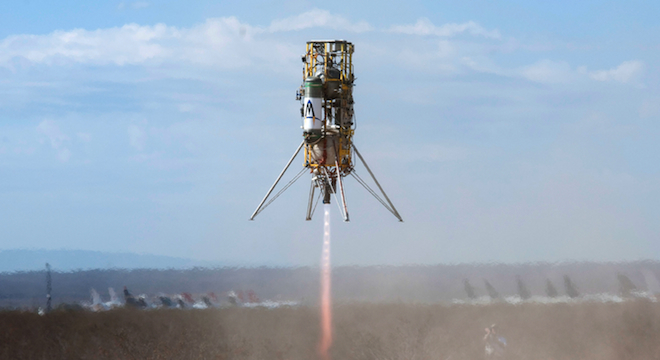Rockets capable of both vertical takeoff and landing aren’t only a goal for Elon Musk’s SpaceX.
Another, lesser-known private rocketry company, Masten Space Systems, on Friday revealed it had finished planned flight tests of one of its reusable rocket prototypes, a 730-pound craft called “Xombie” ahead of schedule, and announced an open call to fly scientific cargo aboard the craft through the end of February, for discounted prices.
Masten is offering to launch customers’ cargo (“your sensor or experiment”) abord its Xombie on two types of low altitude flights in California’s Mojave Desert: A “60 second hop” up to 1,640 feet (500 meters) high, or, a flight 167 feet (51 meters) horizontally across the launch site. The company is willing to talk prices to those interested at 678-551-2253.
“If you have a payload that could benefit from a flight on board Xombie, we could absolutely put air underneath it extraordinarily quickly,” wrote Colin Ake, Masten’s Director of Business Development, in a blog post on the company’s website.
Ake’s blog post notes that Masten’s previous customers include NASA’s Jet Propulsion Laboratory and the nonprofit Draper Laboratory, which, among numerous other concentrations, focuses on advancing space flight and autonomous vehicles.
Masten last week successfully completed a one-minute test launch of its Xombie, thethered to a crane, as NASA tweeted and the company confirmed to TPM. Check out a photo of that test run included in NASA’s tweet:

“The flight test was conducted on the 23rd of January and was about a minute long,” Ake wrote in an email to TPM. “The objective was a standard proficiency flight for our team, part of our normal regime of vehicle and team maintenance. All objectives were achieved.”
Prior to that, in August 2012, Masten’s Xombie performed an “entry descent and landing test,” for NASA’s Jet Propulsion Laboratory to simulate a vertical landing on Mars, traveling 2460 feet, which Masten said was the “the longest terrestrial translation flight ever undertaken by a rocket powered vertical takeoff, vertical landing craft.” Check out video of that here:
One of Masten’s great advances with the Xombie has been the ability for the craft to have its engines cut out and re-light in mid air, as first demonstrated back in 2010 and seen in the following video:
Masten’s Xombie rocket prototypepreviously won second place in the Northrop Grumman Lunar Lander Challenge X Prize of 2009, launching 174 feet (53 meters) up in the air then flying horizontally 164 feet and successfully landing close to the center target of another, separate launch pad, then refueling and flying back. Both times, Masten came an average of within 6.3 inches of its intended target.
Since then, Masten “didn’t fly for some time but was never retired, only waiting for contracts to be signed,” as Ake explained to TPM.
In a brochure for prospective customers (PDF) published in 2011, Masten notes that Xombie is being used for “low speed and low altitude testing.”
But Masten isn’t pinning all of its hopes for developing reliable, reusable vertical takeoff and landing (VTVL) rockets on that craft: It’s also developed two others, the Xoie and Xaero, and is working on a fourth, the Xogdor, each designed to handle successively larger cargo payloads.
Collectively, Masten has flown its first three rockets successfully over 300 times, Ake told TPM.
“We’ve demonstrated the usefulness of these vehicles as vertical landing testbeds and hope to soon prove them as useful platforms for suborbital flight,” Ake said, “Xaero B, our next vehicle, will enter testing soon to help achieve that end.”
Here’s a video from April 2012 of the Xaero B’s engines test firing:
Masten’s craft have already attained higher-altitude flights than that of rival SpaceX‘s Grasshopper VTVL test rocket, which recently reached 130 feet high in a test hop in McGregor, Texas, one of several successively loftier test flights conducted last year.
But Masten’s craft, specifically the Xombie, are much smaller and as such don’t require as much thrust to achieve lift. Masten is also pursuing a distinctly different goal than SpaceX.
“Grasshopper is much larger than Masten’s vehicles and is designed to be the predecessor of a VTVL orbital system, which is significantly different from Masten’s work in landing testbeds and suborbital high altitude flight,” Ake clarified.
That said, the company — founded in 2009 by amateur rocketeer David Masten (now the company’s chief technology officer) — is hoping to play a critical role in creating the next generation of spacecraft and space travel.
“Masten wants to lower the barriers to space access and exploration, including reducing the cost of testing by leveraging our unique testbed capabilities,” Ake said. “Building vehicles that reduce the cost of testing and enable scientists, governments, and companies to demonstrate technologies quickly and cost effectively is one of the primary manners in which we work to achieve that.”
Masten is funded by customers and by private investors, but “not enough,” according to Ake, which also helps explain the call for cargo customers at this time.






